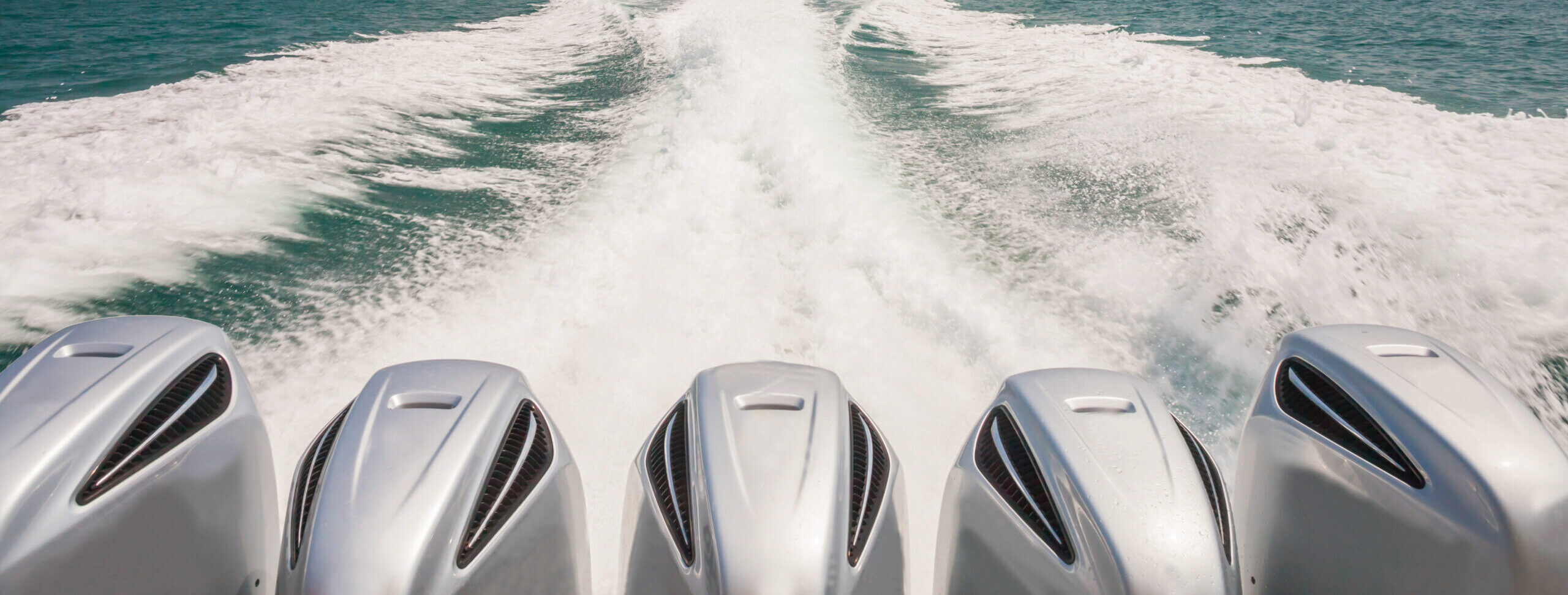Imagine a day on a motor boat on the water. This boat has one or more outboard motors that are transom mounted and centered along the stern. This boat can be anything from a small inflatable boat to a ski boat to a runabout to a large fishing boat. Maybe the boat is at a dock preparing for departure, maybe the boat just floated off a trailer at a local boat ramp, or maybe the boat is ready to weigh anchor off a favorite fishing hole.
The outboard motor/s that handle power, propulsion, and steerage of the boat are in mint condition because the motor/s are maintained regularly. They start the first try every time and run clean all the way to and from their destination.
Imagine if every day on the water was like this.
One can ensure this kind of reliability with a basic understanding of how outboard engines work, and, most importantly, regular boat engine maintenance.
While outboard motors come in many different sizes and shapes, there are certain features that are consistent. All gasoline-powered outboard motors have three main parts from top to bottom:
- The Power Head which is protected by a plastic or fiberglass cover called the engine cowling.
- The Shaft which runs straight down to the lower unit moving power from the engine to the water pump and gears.
- The Lower Unit or gear case houses the gears which turn the propeller and the water pump to circulate water up into the power head keeping the engine cool.
Outboard motors can have an internal fuel tank and/or an external fuel tank, or be connected to fuel tanks integral to the boat. Depending on the size of the motor, fuel is moved into the engine through a carburetor, fuel injection, or direct injection. It is important to know what the fuel delivery system is in your outboard and care for the parts regularly as directed by the manufacturer.
No matter the method of fuel delivery, all outboard motors run best with clean fuel that has no water in it.
Regular Operation and Maintenance Tip #1
Maintaining clean, dry fuel is of prime importance when maintaining your outboard.
- Simply closing the vent on the fuel tank when the boat is not in use or when it is raining are good ways to keep the tank dry.
- Keeping tanks filled leaves little room for condensation which keeps fuel dry.
- Keep fuel line in good condition, with no leaks that can let air or water into your fuel system.
- Flush out fuel from the outboard motor system if taking the motor out of use for the season or if not in daily use. Fuel left in any lines without circulation can be problematic. The easiest way to do this is to detach the fuel line and run the fuel out of the motor.
There are two different types of outboard engines: Two stroke engines, which require mixing fuel with oil and four stroke engines, which have the fuel and oil separate. Traditionally, four stroke engines are known to be cleaner than two stroke engines because they burn their fuel more efficiently.
Regular Operation and Maintenance Tip #2
Know the specific fuel and oil requirements for your engine
- Two stroke motors use 2 stroke specific oil that is mixed with the fuel directly in the fuel tank.
- Because the oil is in the gas there is no oil or oil filers to change on a 2 stroke motor.
- The oil to gas ratio for 2 stroke motors is very important- refer to the owner’s manual for a specific ratio for your motor.
- Four stroke motors use four stroke specific oil that is not mixed directly with the fuel. Regular oil and oil filter changes are required. These should be done according to the owner's manual. Typically every 100 hours or at least once a year or when putting the motor into off-season storage.
Regular Operation and Maintenance Tip #3
Water is essential for starting and keeping outboard engines running.
- There is a water impeller inside a water pump at the base of the driveshaft at the top of the lower unit. They are responsible for moving water into and around the engine thereby keeping the engine cool. Only ever start an outboard engine in water so the water pump and impeller always have water to move. The impeller can be destroyed if the engine is ever started outside of the water.
- Once the engine is running, keep an eye on water coming out of the engine so that you know there is good flow keeping the engine cool when in use. Check regularly for a constant stream of water.
- Each time the outboard motor is to go out of use do a fresh water flush on the engine. This is particularly important if the motor was in salt water. Hook up a garden hose to the water intake on the lower unit. *Some outboard engines have a hose hook up while others do not. Those that do not have a hose hook up require flushing muffs or if the engine is small enough, the lower unit can be put in a five gallon bucket. Run fresh water through the engine long enough that water coming out of the outflow tube is getting warm… maybe five minutes.
- Some manufacturers recommend replacing the water impeller every 100 hours or once a year.
Outboard motors ignite with a spark generated by a spark plug at the head of every cylinder. If the spark plugs are gummed up or fouled the outboard motor will not start well, run well, or it will not start at all.
Regular Maintenance Tip #4
Keep the spark plugs clean and gapped properly
- Clean each electrode (´L´ shaped piece of metal on the inside end of the spark plug) with 220 grit sandpaper and/or a file until it looks like bare metal. Clean threads with a wire brush and cleaning agent. Carb cleaner from an auto parts store works well.
- If the spark plugs look too fouled or gummed, replace and gap correctly. Refer to owner’s manual for gap distance
- It is recommended to check spark plugs annually or every 100 hours and clean. Replace as needed or every 300 hours whichever comes first
The greater the number of cylinders the greater the horsepower and the greater the number of parts moving in the system. Lubricating moving parts and keeping everything clean that moves in the system is essential to maintaining power, potential, and efficiency.
Regular Operation and Maintenance Tip #5
Oil and anti-corrosives are key elements in the lubrication of the moving parts of all outboard motors:
- Regularly open the engine cowling and Spray and/or wipe down moving parts with an anti-corrosive like WD-40 or Quik-lube.
- On 4 Strokes check the oil level regularly. Change as recommended above.
- Lower unit oil changes are important for lubricating gears so gears turning the propeller run smooth and clean. The common recommendation is to change the gear oil every 100 hours. At this time inspect and/or change seals and o-rings in the lower unit to keep the system water tight.
Outboard motors start manually or electrically. Manual starts are initiated by pulling out the choke, squeezing the ball on the fuel line, and pulling on the pull cord. As the engine starts rev the throttle gently while pushing the choke back in. Electric start motors require the starter is connected to the batteries to start. Push the button or turn the key to start the engine. Conversely electric start motors require the battery switch to be turned off when the motor is not in use lest the battery dies.
Lastly, safely operating an outboard motor requires constant awareness of the propeller/s on the lower unit/s. Wearing the safety leash attached to the kill switch ensures that if the operator of the vessel falls overboard the engine and thereby the propeller will immediately stop. Human contact with the moving propeller is exceedingly dangerous and potentially fatal.
Always be certain that the propeller/s and lower unit/s are in water and free of obstructions when the engine is started and running. Never let anything from fishing line to kelp or debris come in contact with the propeller while the engine is in gear: moving forward or back. These things can quickly get entangled in the propeller or simply hang on the forward end of the lower unit causing the propeller to cavitate. If this happens, put the boat in neutral, stop the engine, tilt the engine upwards, and lift the propeller out of the water. Remove anything that has wrapped itself around the prop. Carrying a knife or cutters can be helpful. Once clear, tilt the engine back down so the propeller and lower unit are again in the water before starting the engine in neutral again. With propellers clear of any and all obstructions and set in the water, one can start the engine.
Whether you are turning the key or pulling out the choke and tugging on the pull cord, whether it is the first, the 20th, or your last day of your boating season, ideally your engine starts on the first attempt every time. Every boater can help themselves to greater motor reliability by knowing the details of their outboard motor. Referring to the owner’s manual for ongoing and regular maintenance schedules will help you have the confidence to care for your outboard motor. Good care and regular maintenance will pay off with every clean start so that you may enjoy your time on the water.


